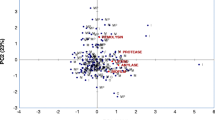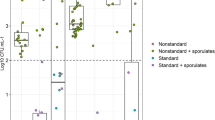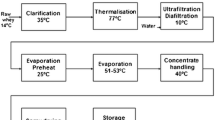Abstract
The elimination of spore-forming bacteria is not guaranteed by current pasteurisation processes and is a challenging problem for the dairy industry. Given that Bacillus cereus sensu lato (B. cereus group) is an important foodborne pathogen and spoiler in the dairy industry, this study aimed at evaluating the prevalence and characteristics of B. cereus group in raw and pasteurised milk samples collected in Victoria, Australia. Isolated B. cereus group were tested for antimicrobial susceptibility, biofilm formation and virulence properties. Genetic diversity was assessed using ERIC-PCR. Proteomic profiling using MALDI-TOF MS and chemical profiling using Fourier-transform infrared (FTIR) spectroscopy were also applied for clustering of the isolates. Results showed 42.3% of milk samples contained B. cereus group, with a higher contamination level for pasteurised milk. Virulence studies identified genes nheA, nheB, hblA and nheC in most isolates and cyk gene in 46% of all isolates. Antimicrobial susceptibility testing showed a high prevalence of resistance towards ampicillin, ceftriaxone and penicillin. The biofilm-forming capacity of our isolates showed that most (53.7%) had the ability to form a biofilm. Genetic profiling using ERIC-PCR placed most B. cereus group isolates from pasteurised milk in the same cluster, indicating that they probably originated from a similar source. Raw milk isolates showed greater diversity indicating various sources. FTIR spectroscopy showed high agreement with genetic profiling. In contrast, low agreement between proteomic (MALDI-TOF MS) and genetic typing was observed. The present study showed that the FTIR spectroscopy could be adopted as a rapid tool for the typing of B. cereus group. Overall, the virulence and antimicrobial resistance characteristics, together with the ability of isolates to produce biofilm, indicate the importance of B. cereus group in the Australian dairy industry.





Similar content being viewed by others
References
Porcellato D, Aspholm M, Skeie SB, Mellegard H (2019) Application of a novel amplicon-based sequencing approach reveals the diversity of the Bacillus cereus group in stored raw and pasteurized milk. Food Microbiol 81:32–39. https://doi.org/10.1016/j.fm.2018.01.014
Gdoura-Ben Amor M, Siala M, Zayani M, Grosset N, Smaoui S, Messadi-Akrout F, Baron F, Jan S, Gautier M, Gdoura R (2018) Isolation, Identification, Prevalence, and Genetic Diversity of Bacillus cereus Group Bacteria From Different Foodstuffs in Tunisia. Front Microbiol 9(447):447. https://doi.org/10.3389/fmicb.2018.00447
Mugadza DT, Buys EM (2017) Diversity of Bacillus cereus strains in extended shelf life. Int Dairy J 73:144–150. https://doi.org/10.1016/j.idairyj.2017.06.001
Kumari S, Sarkar PK (2016) Bacillus cereus hazard and control in industrial dairy processing environment. Food Control 69:20–29. https://doi.org/10.1016/j.foodcont.2016.04.012
Griffiths, M.W., Schraft, H (2017) Bacillus cereus Food Poisoning. In: Foodborne Diseases. Academic Press, pp. 395–405.
Merzougui S, Lkhider M, Grosset N, Gautier M, Cohen N (2013) Differentiation by molecular typing of Bacillus cereus isolates from food in Morocco: PFGE-ERIC PCR. Food and Public Health 3(4):223–227. https://doi.org/10.5923/j.fph.20130304.06
Yu S, Yu P, Wang J, Li C, Guo H, Liu C, Kong L, Yu L, Wu S, Lei T, Chen M, Zeng H, Pang R, Zhang Y, Wei X, Zhang J, Wu Q, Ding Y (2019) A Study on Prevalence and Characterization of Bacillus cereus in Ready-to-Eat Foods in China. Front Microbiol 10(3043):3043. https://doi.org/10.3389/fmicb.2019.03043
Organji SR, Abulreesh HH, Elbanna K, Osman GEH, Khider M (2015) Occurrence and characterization of toxigenic Bacillus cereus in food and infant feces. Asian Pac J Trop Bio 5(7):515–520. https://doi.org/10.1016/j.apjtb.2015.04.004
Hussain MS, Oh DH (2017) Substratum attachment location and biofilm formation by Bacillus cereus strains isolated from different sources: Effect on total biomass production and sporulation in different growth conditions. Food Control 77:270–280. https://doi.org/10.1016/j.foodcont.2017.02.014
McAuley CM, McMillan K, Moore SC, Fegan N, Fox EM (2014) Prevalence and characterization of foodborne pathogens from Australian dairy farm environments. J Dairy Sci 97(12):7402–7412. https://doi.org/10.3168/jds.2014-8735
Fernandes CJ, Ackerman VP (1989) Antibiotic resistance in Australia with special reference to sulbactam/ampicillin. Diagn Microbiol Infect Dis 12(4 Suppl):153S–157S. https://doi.org/10.1016/0732-8893(89)90128-4
Eglezos S, Huang B, Dykes GA, Fegan N (2010) The prevalence and concentration of Bacillus cereus in retail food products in Brisbane. Australia Foodborne pathogens and disease 7(7):867–870. https://doi.org/10.1089/fpd.2009.0469
Li W, Raoult D, Fournier PE (2009) Bacterial strain typing in the genomic era. FEMS Microbiol Rev 33(5):892–916. https://doi.org/10.1111/j.1574-6976.2009.00182.x
Fei P, Yuan X, Zhao S, Yang T, Xiang J, Chen X, Zhou L, Ji M (2019) Prevalence and genetic diversity of Bacillus cereus isolated from raw milk and cattle farm environments. Curr Microbiol 76(11):1355–1360. https://doi.org/10.1007/s00284-019-01741-5
Jadhav S, Bhave M, Palombo EA (2012) Methods used for the detection and subtyping of Listeria monocytogenes. J Microbiol Methods 88(3):327–341. https://doi.org/10.1016/j.mimet.2012.01.002
Welker M, Moore ER (2011) Applications of whole-cell matrix-assisted laser-desorption/ionization time-of-flight mass spectrometry in systematic microbiology. Syst Appl Microbiol 34(1):2–11. https://doi.org/10.1016/j.syapm.2010.11.013
Lasch P, Jacob D, Grunow R, Schwecke T, Doellinger J (2016) Matrix-assisted laser desorption/ionization time-of-flight (MALDI-TOF) mass spectrometry (MS) for the identification of highly pathogenic bacteria. TrAC, Trends Anal Chem 85:103–111. https://doi.org/10.1016/j.trac.2016.04.013
Jadhav S, Gulati V, Fox EM, Karpe A, Beale DJ, Sevior D, Bhave M, Palombo EA (2015) Rapid identification and source-tracking of Listeria monocytogenes using MALDI-TOF mass spectrometry. Int J Food Microbiol 202:1–9. https://doi.org/10.1016/j.ijfoodmicro.2015.01.023
Sheikha El, LevinREe AF, Xu JE (2018) Molecular techniques in food biology : safety, biotechnology, authenticity and traceability, First, edition edn. John Wiley & Sons Ltd., Hoboken, NJ
Dinkelacker AG, Vogt S, Oberhettinger P, Mauder N, Rau J, Kostrzewa M, Rossen JWA, Autenrieth IB, Peter S, Liese J (2018) Typing and Species Identification of Clinical Klebsiella Isolates by Fourier Transform Infrared Spectroscopy and Matrix-Assisted Laser Desorption Ionization-Time of Flight Mass Spectrometry. J Clin Microbiol. https://doi.org/10.1128/JCM.00843-18
Campos J, Sousa C, Mourao J, Lopes J, Antunes P, Peixe L (2018) Discrimination of non-typhoid Salmonella serogroups and serotypes by Fourier Transform Infrared Spectroscopy: A comprehensive analysis. Int J Food Microbiol 285:34–41. https://doi.org/10.1016/j.ijfoodmicro.2018.07.005
Novais A, Freitas AR, Rodrigues C, Peixe L (2019) Fourier transform infrared spectroscopy: unlocking fundamentals and prospects for bacterial strain typing. Eur J Clin Microbiol Infect Dis 38(3):427–448. https://doi.org/10.1007/s10096-018-3431-3
Te Giffel MC, Beumer RR, Granum PE, Rombouts FM (1997) Isolation and characterisation of Bacillus cereus from pasteurised milk in household refrigerators in The Netherlands. Int J Food Microbiol 34(3):307–318. https://doi.org/10.1016/s0168-1605(96)01204-4
Greenwood, M., Roberts, D.P.D., Wiley, I (2002) Practical food microbiology, 3rd edition. Malden, Mass. : Blackwell Pub.
Mohammadi M, Torkamaneh D, Hashemi M, Mehrabi R, Ebrahimi A (2012) Fast and inexpensive DNA isolation from wheat (Triticum aestivum) and other small grains. Wheat Information Service. Electronic Newsletter for Wheat Researchers 114:17–20
CLSI: Performance Standards for Antimicrobial Susceptibility Testing (2017) In, vol. CLSI supplement M100. Wayne PA: Clinical and Laboratory Standards Institute.
Kadam SR, den Besten HM, van der Veen S, Zwietering MH, Moezelaar R, Abee T (2013) Diversity assessment of Listeria monocytogenes biofilm formation: impact of growth condition, serotype and strain origin. Int J Food Microbiol 165(3):259–264. https://doi.org/10.1016/j.ijfoodmicro.2013.05.025
Stepanovic S, Cirkovic I, Ranin L, Svabic-Vlahovic M (2004) Biofilm formation by Salmonella spp and Listeria monocytogenes on plastic surface. Lett Appl Microbiol 38(5):428–432. https://doi.org/10.1111/j.1472-765X.2004.01513.x
Gillings M, Holley M (1997) Repetitive element PCR fingerprinting (rep-PCR) using enterobacterial repetitive intergenic consensus (ERIC) primers is not necessarily directed at ERIC elements. Lett Appl Microbiol 25(1):17–21. https://doi.org/10.1046/j.1472-765x.1997.00162.x
Hathaway LJ, Martynova BS, Aebi S, Mühlemann K (2007) Use of the Agilent 2100 bioanalyzer for rapid and reproducible molecular typing of Streptococcus pneumoniae. J Clin Microbiol 45(3):803–809. https://doi.org/10.1128/JCM.02169-06
Vithanage NR, Yeager TR, Jadhav SR, Palombo EA, Datta N (2014) Comparison of identification systems for psychrotrophic bacteria isolated from raw bovine milk. Int J Food Microbiol 189:26–38. https://doi.org/10.1016/j.ijfoodmicro.2014.07.023
Veloo AC, Knoester M, Degener JE, Kuijper EJ (2011) Comparison of two matrix-assisted laser desorption ionisation-time of flight mass spectrometry methods for the identification of clinically relevant anaerobic bacteria. Clin Microbiol Infect 17(10):1501–1506. https://doi.org/10.1111/j.1469-0691.2011.03467.x
Levesque S, Dufresne PJ, Soualhine H, Domingo MC, Bekal S, Lefebvre B, Tremblay C (2015) A side by side comparison of bruker biotyper and VITEK MS: Utility of MALDI-TOF MS technology for microorganism identification in a public health reference laboratory. PLoS ONE 10(12):e0144878. https://doi.org/10.1371/journal.pone.0144878
Granlund I, Kieselbach T, Alm R, Schroder WP, Emanuelsson C (2011) Clustering of MS spectra for improved protein identification rate and screening for protein variants and modifications by MALDI-MS/MS. J Proteomics 74(8):1190–1200. https://doi.org/10.1016/j.jprot.2011.04.008
Gao T, Ding Y, Wu Q, Wang J, Zhang J, Yu S, Yu P, Liu C, Kong L, Feng Z, Chen M, Wu S, Zeng H, Wu H (2018) Prevalence, Virulence Genes, Antimicrobial Susceptibility, and Genetic Diversity of Bacillus cereus Isolated From Pasteurized Milk in China. Front Microbiol 9(533):533. https://doi.org/10.3389/fmicb.2018.00533
Helgason E, Caugant DA, Lecadet MM, Chen Y, Mahillon J, Lovgren A, Hegna I, Kvaloy K, Kolsto AB (1998) Genetic diversity of Bacillus cereus/B thuringiensis isolates from natural sources. Curr Microbiol 37(2):80–87. https://doi.org/10.1007/s002849900343
Chaves JQ, Pires ES, Vivoni AM (2011) Genetic diversity, antimicrobial resistance and toxigenic profiles of Bacillus cereus isolated from food in Brazil over three decades. Int J Food Microbiol 147(1):12–16. https://doi.org/10.1016/j.ijfoodmicro.2011.02.029
Larsen HD, Jorgensen K (1997) The occurrence of Bacillus cereus in Danish pasteurized milk. Int J Food Microbiol 34(2):179–186. https://doi.org/10.1016/s0168-1605(96)01182-8
Granum PE, Stenfors Arnesen L, From C (2014) Bacteria: Bacillus cereus and Other Pathogenic Bacillus Species A2 - Motarjemi, Yasmine. Encyclopedia of Food Safety. Academic Press, Waltham, pp 356–363
Artursson K, Schelin J, Thisted Lambertz S, Hansson I, Olsson Engvall E (2018) Foodborne pathogens in unpasteurized milk in Sweden. Int J Food Microbiol 284:120–127. https://doi.org/10.1016/j.ijfoodmicro.2018.05.015
Porcellato D, Aspholm M, Skeie SB, Monshaugen M, Brendehaug J, Mellegård H (2018) Microbial diversity of consumption milk during processing and storage. Int J Food Microbiol 266:21–30. https://doi.org/10.1016/j.ijfoodmicro.2017.11.004
Arslan S, Eyi A, Kucuksari R (2014) Toxigenic genes, spoilage potential, and antimicrobial resistance of Bacillus cereus group strains from ice cream. Anaerobe 25:42–46. https://doi.org/10.1016/j.anaerobe.2013.11.006
Li F, Zuo S, Yu P, Zhou B, Wang L, Liu C, Wei H, Hengyi X (2016) Distribution and expression of the enterotoxin genes of Bacillus cereus in food products from Jiangxi Province, China. Food Control 67:155–162. https://doi.org/10.1016/j.foodcont.2016.02.049
Owusu-Kwarteng J, Wuni A, Akabanda F, Tano-Debrah K, Jespersen L (2017) Prevalence, virulence factor genes and antibiotic resistance of Bacillus cereus sensu lato isolated from dairy farms and traditional dairy products. BMC Microbiol 17(1):65. https://doi.org/10.1186/s12866-017-0975-9
Zhao S, Chen J, Fei P, Feng H, Wang Y, Ali MA, Li S, Jing H, Yang W (2020) Prevalence, molecular characterization, and antibiotic susceptibility of Bacillus cereus isolated from dairy products in China. J Dairy Sci 103(5):3994–4001. https://doi.org/10.3168/jds.2019-17541
Hardy-Holbrook R, Aristidi S, Chandnani V, DeWindt D, Dinh K (2013) Antibiotic resistance and prescribing in Australia: current attitudes and practice of GPs. Healthcare infection 18(4):147–151. https://doi.org/10.1071/hi13019
Teh KH, Flint S, Palmer J, Andrewes P, Bremer P, Lindsay D (2014) Biofilm—An unrecognised source of spoilage enzymes in dairy products? Int Dairy J 34(1):32–40. https://doi.org/10.1016/j.idairyj.2013.07.002
Tang X, Flint SH, Bennett RJ, Brooks JD (2010) The efficacy of different cleaners and sanitisers in cleaning biofilms on UF membranes used in the dairy industry. J Membr Sci 352(1–2):71–75. https://doi.org/10.1016/j.memsci.2010.01.063
Srey S, Jahid IK, Ha S-D (2013) Biofilm formation in food industries: A food safety concern. Food Control 31(2):572–585. https://doi.org/10.1016/j.foodcont.2012.12.001
Mietke H, Beer W, Schleif J, Schabert G, Reissbrodt R (2010) Differentiation between probiotic and wild-type Bacillus cereus isolates by antibiotic susceptibility test and Fourier transform infrared spectroscopy (FT-IR). Int J Food Microbiol 140(1):57–60. https://doi.org/10.1016/j.ijfoodmicro.2010.02.009
Acknowledgements
This work was supported by Dairy Food Safety Victoria (DFSV). The authors would like to acknowledge Doug Eddy for his help during the project and all technical staff in the Department of Chemistry and Biotechnology, Swinburne University of Technology.
Author information
Authors and Affiliations
Contributions
All authors designed the experiments. BR and TT performed the experimentation and analysed the data. All authors wrote the manuscript.
Corresponding author
Ethics declarations
Conflict of interest
The funders had no role in study design, data collection and analysis, decision to publish, or preparation of the manuscript. Thien Tran is an employee of Bruker Pty. Ltd. All other authors declare no conflict of interest.
Additional information
Publisher's Note
Springer Nature remains neutral with regard to jurisdictional claims in published maps and institutional affiliations.
Rights and permissions
About this article
Cite this article
Radmehr, B., Zaferanloo, B., Tran, T. et al. Prevalence and Characteristics of Bacillus cereus Group Isolated from Raw and Pasteurised Milk. Curr Microbiol 77, 3065–3075 (2020). https://doi.org/10.1007/s00284-020-02129-6
Received:
Accepted:
Published:
Issue Date:
DOI: https://doi.org/10.1007/s00284-020-02129-6




